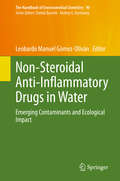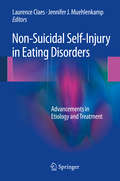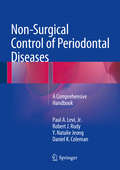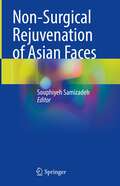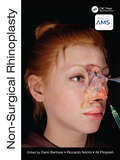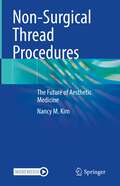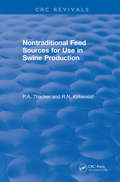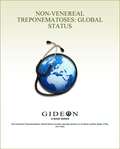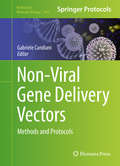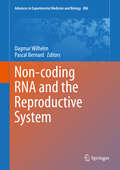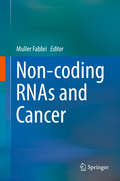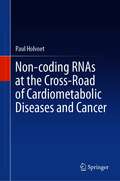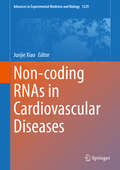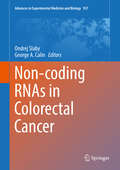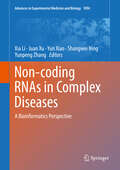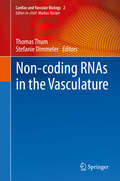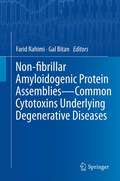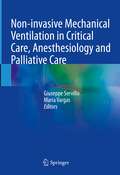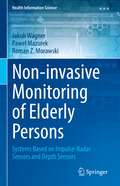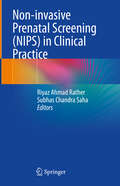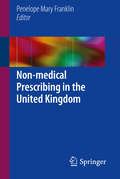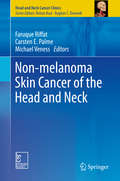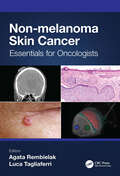- Table View
- List View
Non-Steroidal Anti-Inflammatory Drugs in Water: Emerging Contaminants and Ecological Impact (The Handbook of Environmental Chemistry #96)
by Leobardo Manuel Gómez-OlivánThis book gathers the main international research findings on non-steroidal anti-inflammatory drugs (NSAIDs) as emerging contaminants in water. It focuses on the major routes of exposure, and the destinations and life cycles of NSAIDs in water, as well as the manifestations of toxicity in different organisms. It also reviews the methods used in the detection, analysis and quantification of NSAIDs in water as well as the biological and chemical methods of removing them. Lastly, the book offers an overview of the legal frameworks in place and provides conclusions and recommendations for the future. Given its scope, the book is an indispensable resource for scientists in academia and industry, as well as for decision-makers involved in contamination assessment and environmental analysis and NGOs interested in the problem of water contamination by NSAIDs.
Non-Suicidal Self-Injury in Eating Disorders
by Laurence Claes Jennifer J. MuehlenkampNon-suicidal self-injury and eating disorders represent significant problems among today's youth and pose unique challenges for clinicians, particularly when they co-occur. This book is a rare resource in that it provides cutting-edge information on the interactions between self-injury and disordered eating, empirically informed treatments for the co-occurrence of these behaviors, and specific topics relevant to understanding nuances in the risk factors, treatment, and prevention of both self-injury and eating disorders. Practitioners, graduate students, and researchers working within this specialized area will find this text to be instrumental in advancing their knowledge and improving the treatment of self-injury in those with eating disorders.
Non-Surgical Control of Periodontal Diseases
by Paul A. Levi Y. Natalie Jeong Robert J. Rudy Daniel K. ColemanThis handbook has been designed for practicing dental clinicians and students, which includes dental hygienists, general dentists, periodontists, and students of dental hygiene and dentistry who are responsible for treating patients with a broad spectrum of periodontal diseases. The book will enable practicing clinicians and students to successfully meet the challenge of excellent patient care, by providing , in a concise and simplified format, both classic and contemporary practical measures that address all aspects of non-surgical periodontal disease management. Readers are carefully guided through an extensive body of accumulated knowledge in eight broad chapters which includes: the patient's involvement in disease control and prevention, the clinician's instrumentation for the diagnosis and basic treatment of gingivitis/periodontitis along with pharmacotherapeutics and supportive maintenance therapy to ensure long-term success. Numerous illustrations help to bring the presented ideas and suggestions to life and the succinct nature of the text will allow readers to transfer useful information quickly to their own clinical settings.
Non-Surgical Rejuvenation of Asian Faces
by Souphiyeh SamizadehThis book provides a practically applicable guide to facial aesthetics, non-surgical treatment and enhancement in patients of Asian descent. The available evidence base for the use of a range of available techniques when treating an Asian patient is presented and relevant aspects of facial analysis, treatment planning and provision are covered. Detailed instruction is given on how to use cutting edge techniques enabling the reader to develop a thorough understanding of how to proficiently perform these approaches in their clinical practice. Non-Surgical Rejuvenation of Asian Faces systematically reviews the evidence base for and details how to use the latest available non-surgical techniques for facial rejuvenation in this group of patients. It is a valuable resource for aesthetic medicine professionals and trainees alike seeking a reference on the topic.
Non-Surgical Rhinoplasty (The PRIME Series)
by Ali Pirayesh Dario Bertossi Riccardo Nocini*Brings together all a surgeon needs to know for safe and effective non-invasive rhinoplasty *Offers a one-stop resource for surgeons wishing to add injection techniques to their practice *Presents a master-class from world experts
Non-Surgical Thread Procedures: The Future of Aesthetic Medicine
by Nancy M. KimThis book provides knowledge and instruction about thread procedures that are the current state of the art in the United States. The book offers a comprehensive overview of the threads available and in favor of use in the US. The chemical and biological activity of the threads also will be explained. Chapters will discuss research that support the theory and clinical efficacy of the threads, thus laying the foundation for understanding the purpose of the threads. Chapters discuss the different types, sizes and styles of threads in current use. The various areas and procedures that are possible with the threads will be described in detail to allow practitioners a greater comfort level when learning these procedures. The book will also include tips to help practitioners succeed with these procedures as it is generally not as straight forward as some other aesthetic procedures. In addition, the book compares and contrasts thread procedures with other current modalities. This will delineate the advantages of threads over other treatments for aesthetic treatment including surgery. The book also contains multiple videos that show the use of threads in various procedures.Non-Surgical Thread Procedures is a must-have resource for clinicians and physicians that practice minimally invasive aesthetic procedures as well as those interested in thread procedures.
Non-Surgical Treatment of Keratinocyte Skin Cancer
by Gregor Jemec Lajos Kemeny Donald MiechWith more and more patients suffering from field cancerisation, an alternative for repeated surgery for the diagnosis and treatment of non-melanoma skin cancer is becoming necessary. Although surgery remains the gold standard for treatment of non-melanoma or keratinocyte skin cancer, it also has its downside. Surgery leaves scars and nowadays the cosmetic outcome of therapy is becoming increasingly important. Since many cases can effectively be managed without surgery, the possibilities of non-surgical therapy are gaining popularity, particularly in low malignancy tumours. This reader-friendly clinical guide offers treatment options for the growing group of these patients. It describes the current state-of-the art for non-surgical treatment of this type of skin cancer, and gives factual knowledge to beginners and new inspirations to experts.
Non-Traditional Feeds for Use in Swine Production (CRC Press Revivals)
by Phillip A Thacker Roy N KirkwoodFeed represents the single greatest expense associated with bringing pigs to market weight. Therefore, if you can reduce the cost of feeding without detriment to pig performance, the economics of swine production will improve. The ingredient list for swine rations has become fairly limited, and the majority of diets fed to pigs consist of a few staples, such as corn, wheat, barley, and soybean meal. Non-Traditional Feeds for Use in Swine Production explores over fifty non-traditional feedstuffs in terms of their nutritional content and their viability as alternative, cost effective food sources
Non-Vascular Interventional Radiology of the Abdomen
by Ronald S. ArellanoThis book is designed to provide a foundation for physicians-in-training and a quick guide to further enhance the skills set of practicing interventionalists. It is a concise reference manual covering the major aspects of clinical scenarios, procedures, and techniques. Non-Vascular Interventional Radiology of the Abdomen expertly addresses the planning and execution of commonly encountered procedures, including organ specific biopsies, abscess drainage, urinary interventions, gastrostomy, gastrojejunostomy, and biliary interventions.
Non-Venereal Treponematoses: Global Status 2010 edition
by Dr Stephen Berger Gideon InformaticsNon-Venereal Treponematoses: Global Status is one in a series of GIDEON ebooks which summarize the status of individual infectious diseases, in every country of the world. Data are based on the GIDEON database (www.gideononline.com) which relies on standard text books, peer-review journals, Health Ministry reports and ProMED, supplemented by an ongoing search of the medical literature. Chapters are arranged alphabetically, by country name. Each section is divided into five subsections. 1. Descriptive epidemiology 2. Summary of clinical features 3. Global status of the disease 4. Status of the disease in a specific country 5. References Non-Venereal Treponematoses: Global Status includes separate sections on Endemic syphilis (bejel), Pinta, and Yaws.
Non-Viral Gene Delivery Vectors
by Gabriele CandianiThis volume provides readers with a wide collection of the latest and readily reproducible technical protocols available in the field of non-viral gene delivery vectors. The chapters in this book are organized into three major parts: Part I is a section on conventional bolus gene delivery vectors that introduces typical transfection approaches relying on the addition of transfectants to the cell culture medium where the cells are grown in; Part II covers stimuli-responsive bolus transfectants and topics on gene delivery complexes made of smart polymers or stimuli-responsive polymers that change according to the environment they are in and delivered by dripping into cells; Part III discusses examples of substrate-mediated gene delivery also termed reverse transfection and the immobilization of a gene delivery vector onto a surface as opposed to more typical bolus delivery from the medium. Written in the highly successful "Methods in Molecular Biology" series format, chapters include introductions to their respective topics, lists of the necessary materials and reagents, step-by-step, readily reproducible laboratory protocols, and tips on troubleshooting and avoiding known pitfalls. Cutting-edge and practical, "Non-Viral Gene Delivery Vectors: Methods and Protocols "is written for experimentalists, and is an essential part of many laboratory bookshelves. This book will help novice and professionals alike succeed in their research in this field. "
Non-coding RNA and the Reproductive System
by Dagmar Wilhelm Pascal BernardThis book provides an overview of the role and function of regulatory RNAs that lack protein-coding potential in key reproductive tissues. This includes the role of small interfering RNAs (siRNAs), microRNAs (miRNAs), PIWI-interacting RNAs (piRNAs), small nucleolar RNAs (snoRNAs) and long non-coding RNAs (lncRNAs). Through clear, detailed and comprehensive debate, international leading experts discuss the role these novel regulators in normal development of sexual dimorphisms, including the differentiation of ovaries and testes, the genital tract including prostate, epididymis and uterus, as well as mammary glands. In addition, particular attention is paid on their role in pathophysiological processes within the reproductive tract. The power of next generation sequencing has proved to be an invaluable tool to discover new non-coding RNAs. While the identification of non-coding RNA is relatively easy, analysing their function represents still a challenge today. In this book, authors present historical and conceptual background information, highlight the ways in which non-coding RNAs function is analysed and present their vision of the future research in their key research area.
Non-coding RNAs and Cancer
by Muller FabbriThe discovery of microRNAs and its role as gene expression regulators in human carcinogenesis represents one of the most important scientific achievements of the last decade. More recently, other non-coding RNAs have been discovered and its implications in cancer are emerging as well, suggesting a broader than anticipated involvement of the non-coding genome in cancer. Moreover, completely new and unexpected functions for microRNAs are being revealed, leading to the identification of new anticancer molecular targets. This book represents a comprehensive guide on non-coding RNAs and cancer, spanning from its role as cancer biomarkers, to providing the most useful bioinformatic tools, to presenting some of the most relevant discoveries, which indicates how these fascinating molecules act as fine orchestrators of cancer biology.
Non-coding RNAs at the Cross-Road of Cardiometabolic Diseases and Cancer
by Paul HolvoetThis book gives insight into the functional role of non-coding RNAs in central pathways contributing to the development of obesity, type 2 diabetes, non-alcoholic fatty liver disease, atherosclerosis, myocardial infarction, cardiomyopathy, and heart failure. It also sheds light on the relationship of this cluster with cancer. Tumor cells, in contrast to cells in cardiometabolic tissues, can regulate this cluster of non-coding RNAs to escape from oxidative stress and anti-tumor immunity and maintain insulin sensitivity, facilitating cancer progression. The book presents a cluster of non-coding RNAs that may be prospectively analyzed in extensive cohort studies to determine their value in risk-predicting machine learning algorithms. In addition, it emphasizes the role of microvesicles in communication between tumor-adjacent tissue, inflammatory cells, and tumor cells, with a special focus on the role of miR-155. The book intends to promote interdisciplinary research. Due to the comprehensive background information provided in each chapter, it is suitable for researchers in academia and industry and for graduate students in biology, bioengineering, and medicine.
Non-coding RNAs in Cardiovascular Diseases (Advances in Experimental Medicine and Biology #1229)
by Junjie XiaoThis book presents the latest research on non-coding RNAs in cardiovascular disease, a major cause of death worldwide. Non-coding RNAs play a significant role in development, proliferation, differentiation and apoptosis. Since altered non-coding RNA expression is often associated with various diseases, their potential use in diagnostics, prognostics and therapeutics is an important current area of study. The book consists of six parts: 1) An overview of non-coding RNAs and cardiovascular system, 2) Bioinformatics and interactions, 3) Non-coding RNA regulation in cardiovascular system, 4) Non-coding RNAs and cardiovascular diseases, 5) Potential biomarkers and therapeutic implications, 6) Future prospects. It is particularly useful for researchers and students in the field of non-coding RNA and cardiovascular biology, as well as for cardiologists, pharmacologists and physiologists.
Non-coding RNAs in Colorectal Cancer
by Ondrej Slaby George A. CalinThis is the first book to provide a broad framework for obtaining an in depth understanding of the state-of-the-art knowledge on abnormalities of non-coding RNAs found to be associated with colorectal cancer pathogenesis. Readers will discover possible mechanisms underlying the substantial roles played by non-coding RNAs in molecular hallmarks of colorectal cancer. This work further provides the comprehensive overview and novel insights into using of non-coding RNAs as colorectal cancer biomarkers enabling early detection of the disease, prognostic stratification of the patients and prediction of therapeutic response. The reader is introduced to the overview of modern non-coding RNAs-based therapeutic strategies, and summary of their preclinical testing performed in colorectal cancer. The work is written for researchers who want to explore current state of the knowledge in this interesting field of molecular oncology.
Non-coding RNAs in Complex Diseases: A Bioinformatics Perspective (Advances in Experimental Medicine and Biology #1094)
by Xia Li Juan Xu Yun Xiao Shangwei Ning Yunpeng ZhangThis book offers an in-depth and comprehensive review on current understanding of regulatory ncRNAs in complex diseases from a view of bioinformatics. It conveys state-of-the-art bioinformatics tools and methods for ncRNAs from computational detection, functional prediction, to their roles in diseases. Computational methods used to investigate uncharacterised ncRNAs in diseases are mainly summarized in seven aspects: DNA variation of ncRNAs in diseases, prioritization of disease-related ncRNAs, dysregulation epigenetic factors that regulate ncRNA misexpression (DNA methylation and histone-modification), complex crosstalk across ncRNAs, ncRNAs acted as competing regulators to mediate the expression of protein-coding genes, non-coding RNAs mediated risk pathways,and their contributions to drug target predictions. The generally used data resources of ncRNAs are also listed in the end. This book provides important information on the current progress in the fast-moving fields of bioinformatics for regulatory ncRNAs. It provides a timely and useful reference for computational biologists, specifically with RNA interests, and other related areas.Prof. Xia Li is a Professor and the Dean of College of Bioinformatics Science and Technology, Harbin Medical University, China. Dr. Yun Xiao, Dr. Juan Xu, Dr. Shangwei Ning and Dr. Yunpeng Zhang are from College of Bioinformatics Science and Technology, Harbin Medical University, China.
Non-coding RNAs in the Vasculature (Cardiac and Vascular Biology #2)
by Thomas Thum Stefanie DimmelerThis book focuses on the importance of regulatory RNAs in the vasculature. The main topics discussed include the role of regRNAs in vascular development and angiogenesis, ischemic cardiovascular disease and repair mechanisms, diabetic and metabolic vascular disease, atherosclerosis and vascular inflammation, as well as diagnostics of vascular disease using circulating miRNAs. Lastly, it offers an overview of emerging topics such as microvesicle-mediated miRNA cellular trafficking and the vascular importance of long non-coding RNAs. It is an invaluable resource for academics, researchers and students working in the field of vascular biology.
Non-fibrillar Amyloidogenic Protein Assemblies - Common Cytotoxins Underlying Degenerative Diseases
by Gal Bitan Farid RahimiAmyloid-forming proteins are implicated in over 30 human diseases. The proteins involved in each disease have unrelated sequences and dissimilar native structures, but they all undergo conformational alterations to form fibrillar polymers. The fibrillar assemblies accumulate progressively into disease-specific lesions in vivo. Substantial evidence suggests these lesions are the end state of aberrant protein folding whereas the actual disease-causing culprits likely are soluble, non-fibrillar assemblies preceding the aggregates. The non-fibrillar protein assemblies range from small, low-order oligomers to spherical, annular, and protofibrillar species. Oligomeric species are believed to mediate various pathogenic mechanisms that lead to cellular dysfunction, cytotoxicity, and cell loss, eventuating in disease-specific degeneration and systemic morbidity. The particular pathologies thus are determined by the afflicted cell types, organs, systems, and the proteins involved. Evidence suggests that the oligomeric species may share structural features and possibly common mechanisms of action. In many cases, the structure-function interrelationships amongst the various protein assemblies described in vitro are still elusive. Deciphering these intricate structure-function correlations will help understanding a complex array of pathogenic mechanisms, some of which may be common across different diseases albeit affecting different cell types and systems.
Non-invasive Mechanical Ventilation in Critical Care, Anesthesiology and Palliative Care
by Giuseppe Servillo Maria VargasThis book provides an easy, modern and practical way for physicians to approach the world of noninvasive mechanical ventilation (NIMV). Noninvasive ventilation is well-established and increasingly used in routine clinical practice. However, some concepts and techniques of NIMV may be difficult to grasp for students or for healthcare professionals with less experience. The book is subdivided into 7 sections covering different aspects of clinical applications of NIMV. From modes of ventilation to the proper moment to start noninvasive ventilation; from critical care applications of NIVM (pre-, intra- and post-hospitalization as well as in emergency medicine), to the use outside of ICUs. Its purpose is also considered in several different diseases and settings, including the experience during Covid-19 pandemic and at the end of life. The book addresses anesthesiologists, critical care, emergency care, palliative care, primary care physicians using noninvasive ventilation and will represent an invaluable tool for a better understanding of this technique.
Non-invasive Monitoring of Elderly Persons: Systems Based on Impulse-Radar Sensors and Depth Sensors (Health Information Science)
by Jakub Wagner Paweł Mazurek Roman Z. MorawskiThis book covers the results of a study concerning systems for healthcare-oriented monitoring of elderly persons. It is focused on the methods for processing data from impulse-radar sensors and depth sensors, aimed at localisation of monitored persons and estimation of selected quantities informative from the healthcare point of view. It includes mathematical descriptions of the considered methods, as well as the corresponding algorithms and the results of their testing in a real-world context. Moreover, it explains the motivations for developing healthcare-oriented monitoring systems and specifies the real-world needs which may be addressed by such systems.The healthcare systems, all over the world, are confronted with challenges implied by the ageing of population and the lack of adequate recruitment of healthcare professionals. Those challenges can be met by developing new technologies aimed at improving the quality of life of elderly people and at increasing the efficiency of public health management. Monitoring systems may contribute to this strategy by providing information on the evolving health status of independently-living elderly persons, enabling healthcare personnel to quickly react to dangerous events. Although these facts are generally acknowledged, such systems are not yet being commonly used in healthcare facilities and households. This may be explained by the difficulties related to the development of technological solutions which can be both acceptable for monitored persons and capable of providing healthcare personnel with useful information. The impulse-radar sensors and depth sensors, considered in this book, have a potential for overcoming those difficulties since they are not cumbersome for the monitored persons – if compared to wearable sensors – and do not violate the monitored person's privacy – if compared to video cameras. Since for safety reasons the level of power, emitted by the radar sensors, must be ultra-low, the task of detection and processing of signals is a research challenge which requires more sophisticated methods than those developed for other radar applications. This book contains descriptions of new Bayesian methods, applicable for the localisation of persons by means of impulse-radar sensors, and an exhaustive review of previously published ones. Furthermore, the methods for denoising, regularised numerical differentiation and fusion of data from impulse-radar sensors and depth sensors are systematically reviewed in this book. On top of that, the results of experiments aimed at comparing the performance of various data-processing methods, which may serve as guidelines for related future projects, are presented.
Non-invasive Prenatal Screening (NIPS) in Clinical Practice
by Riyaz Ahmad Rather Subhas Chandra SahaThe book provides a comprehensive overview of the use of non-invasive prenatal screening (NIPS) in clinical practice. It covers advanced genomic approaches and operational strategies related to NIPS. It aims to fill a gap by offering a thorough historical background and genesis of NIPS technology, including its methodology, clinical utility, challenges, and future directions. The book is divided into three sections: Section I discusses the advent of NIPS, Section II addresses detection strategies and clinical implementation, and Section III explores the challenges and prospects of NIPS technology. The book benefits specialists who practice prenatal medicine as well as reproductive specialists, genetic councilors, research scholars and postgraduate medical students of obstetrics and gynecology.
Non-medical Prescribing in the United Kingdom
by Penelope Mary FranklinThis book explores key developments in Non-medical Prescribing in the UK. Addressing the needs of countries in the European Market and beyond, which have been closely watching UK developments and would be interested in embedding or developing counterparts of their own. Featuring chapters by clinicians, leaders and practitioners in the UK Non-medical Prescribing arena, it identifies both current and potential future developments. Attention is paid to the different prescribing practices and governance within the four countries constituting the United Kingdom. Many lessons have been learned along the way and the purpose of this book is to share these lessons, tog ether with best practice examples in connection with the implementation of nurse/health professional led patient care, implementation of patient centered practice, and governance. Designated Registered Practitioners who have completed an enhanced training now receive a professional body qualification which enables them to prescribe within their scope of practice as Non-medical Independent Prescribers and, providing that they are competent, from anywhere within the British National Formulary independently of doctors; for Nurses, this also includes most controlled drugs. The book will be of interest to policy makers and to forward-looking professionals and practitioners in the diverse European Healt h and Social Care market.
Non-melanoma Skin Cancer of the Head and Neck
by Faruque Riffat Carsten E. Palme Michael VenessNon-melanoma skin cancer is a global public health issue. With an ever-increasing, and ageing, world population coupled with increasing numbers of immunosuppressed individuals the number of patients continues to rise. The head and neck is overwhelmingly the most frequent location for the development of a non-melanoma skin cancer and as such challenges the clinician with its complex anatomy. The importance of maintaining the aesthetics of the face and the function of the anatomy cannot be overstated, yet ultimately it is always the aim of curing a patient with the minimum of morbidity that clinicians strive for. However, the spectrum of presentations and subsequent management varies widely, ranging from patients with the ubiquitous low-risk mid-face basal cell carcinoma to those diagnosed with relatively uncommon but potentially life-threatening high-risk squamous cell carcinomas (e. g. involving metastatic lymph nodes or with perineural invasion present) and Merkel cell carcinomas.
Non-melanoma Skin Cancer: Essentials for Oncologists
by Agata Rembielak and Luca TagliaferriThis book provides a comprehensive introduction to the current state-of-the-art in skin cancer, exploring the recent developments, appraising the current evidence and providing future directions with particular emphasis on interdisciplinary collaboration and need for clinical trials. It covers all aspects of skin cancers, including epidemiology, pathology, surgical and non-surgical treatments. It will be a valuable reference for oncologists, dermatologists, dermatopathologists, surgeons, allied health care professionals and other specialists and trainees with a special interest in skin cancer who want to update their knowledge in the multidisciplinary management of such patients. The book will be of interest to medical physicists and radiographers who would like an overview of the current practice in skin cancer. The book can be used by students in medicine, nursing, radiography and medical physics. Features Provides a comprehensive review of all aspects of skin cancer management. Edited by experts in the area, with interdisciplinary and international collaborators. Promotes a 'Bigger picture' approach to the topic with multidisciplinary insight.
